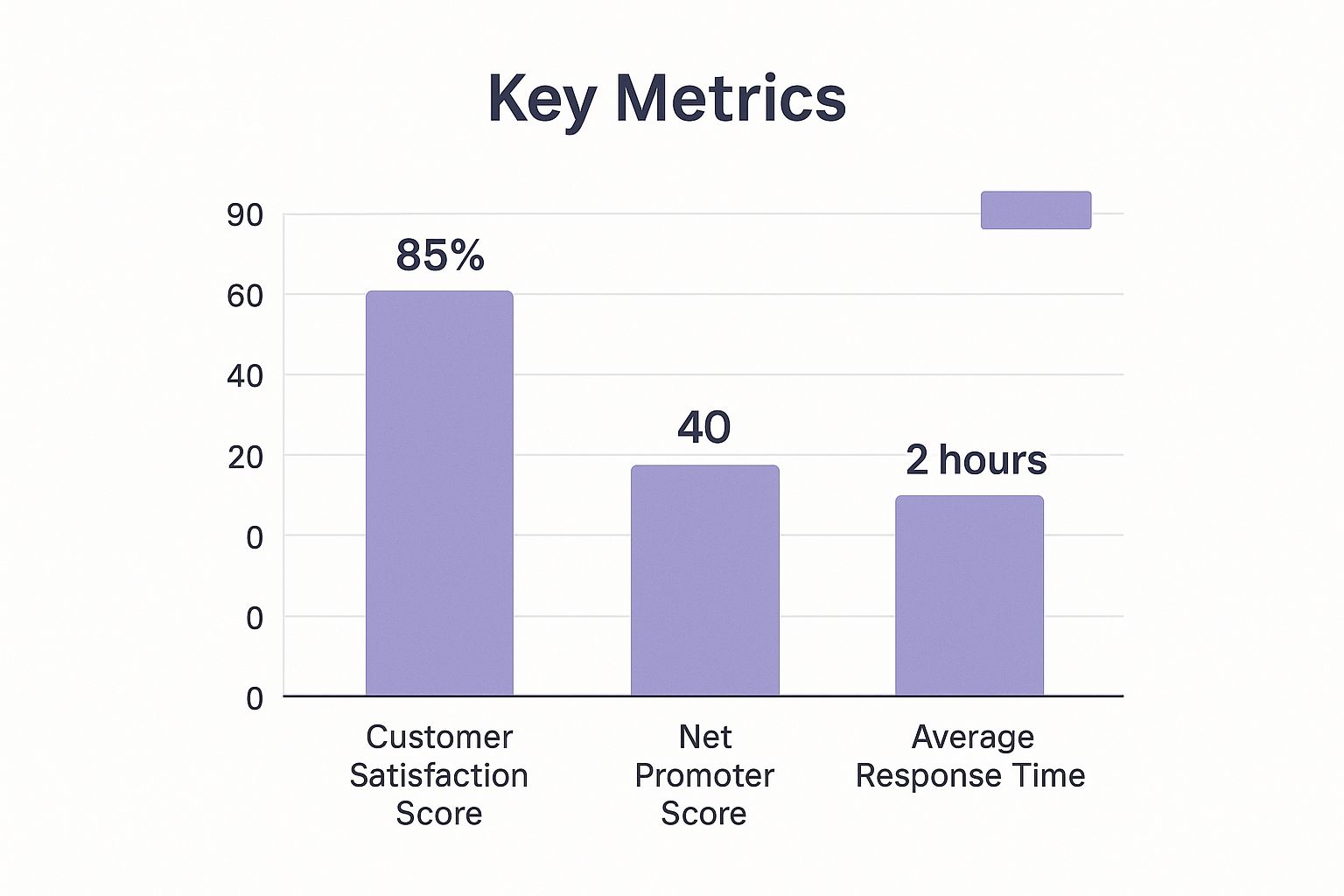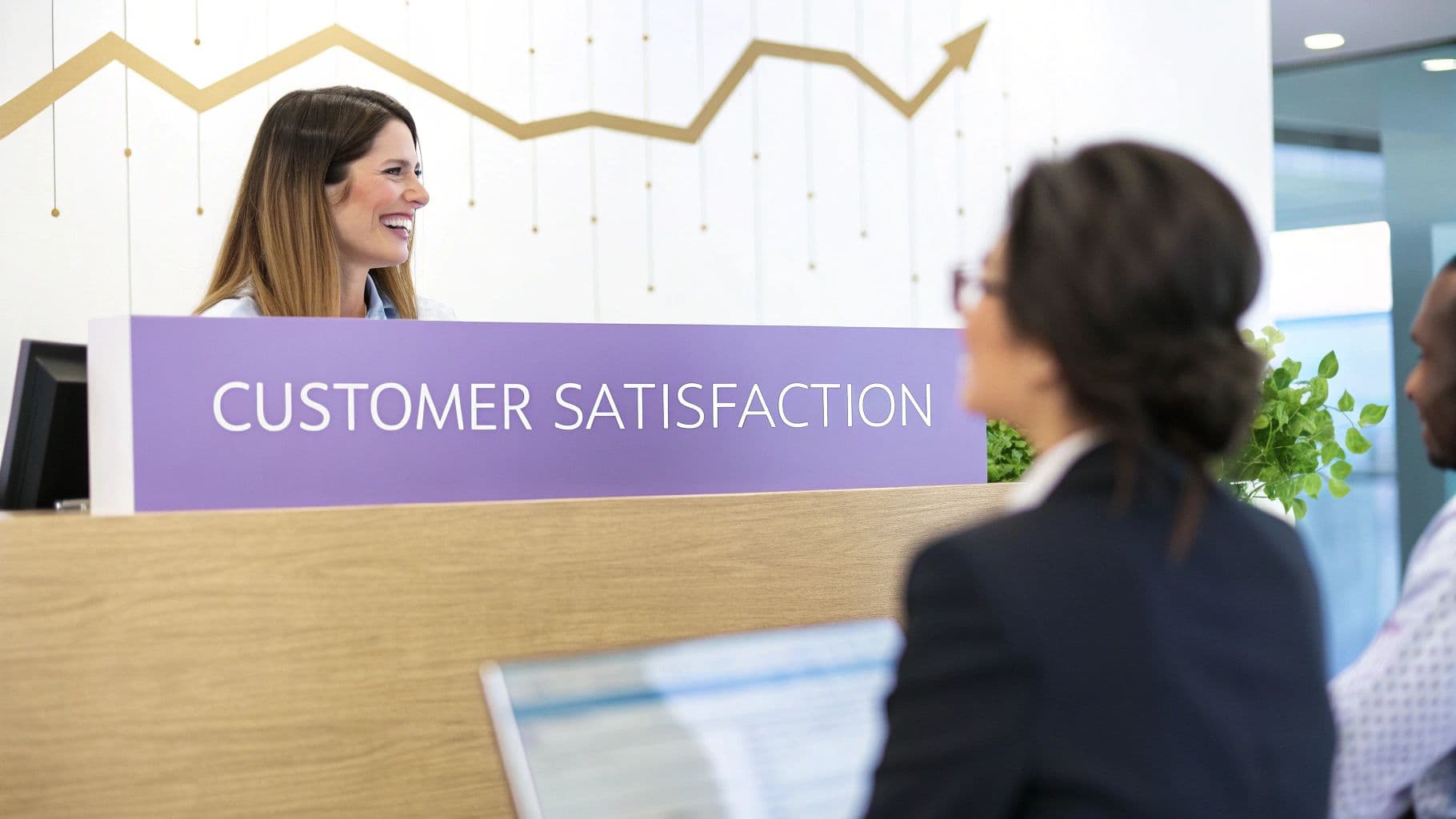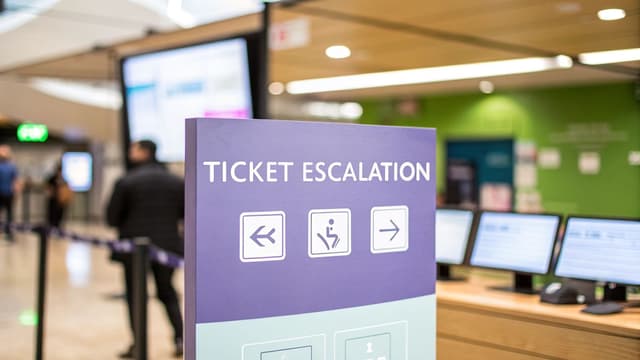The Bottom-Line Impact of Customer Satisfaction

Customer satisfaction is more than just a positive feeling; it has a direct impact on your profits. In today's competitive business world, companies must understand the real financial advantages of providing excellent customer experiences. This includes recognizing how even small interactions can significantly influence a customer's overall value to your business.
The Cost of Dissatisfaction
A crucial part of boosting customer satisfaction is understanding the negative impact of poor service on customer retention. Consistently negative experiences can lead to customers leaving, which directly affects revenue. This is particularly relevant now, as customer expectations are consistently rising. Even one negative interaction can be enough to make a customer consider other options.
This isn't just a theory. A 2025 Zendesk report found that 73% of consumers would switch to a competitor after multiple bad interactions with a business. This shows just how impactful a few negative experiences can be in driving customer churn. However, on a more positive note, 3 out of 4 consumers also said they would spend more with companies that deliver excellent service. For more detailed statistics, check out this link: Discover more insights about customer service statistics.
The Rewards of Exceeding Expectations
On the flip side, prioritizing customer satisfaction offers substantial benefits. This translates to increased customer loyalty, repeat business, and positive word-of-mouth marketing. These outcomes work together, creating natural growth and reducing the cost of acquiring new customers. Essentially, happy customers become your most effective advocates.
Lifetime Value: The Long-Term View
Focusing on customer satisfaction also boosts customer lifetime value (CLTV). CLTV represents the total revenue a business can realistically expect from a single customer account. By creating positive experiences, you encourage repeat purchases and build stronger relationships. This means customers stay with your business longer and spend more over time, directly contributing to predictable, sustainable revenue growth.
Competitive Advantage in a Crowded Market
Today, exceptional customer service isn't just a way to stand out—it's what customers expect. By exceeding those expectations, you create a true competitive advantage. This can be achieved through strategies like personalized service, proactive support, and efficient problem-solving. This builds strong customer loyalty, making it challenging for competitors to win your customers over. It effectively creates a protective barrier around your business.
Measuring What Matters: Customer Satisfaction Metrics That Work

The infographic above illustrates example data for three crucial customer satisfaction metrics: customer satisfaction score calculation (CSAT), Net Promoter Score (NPS), and Average Response Time. Maintaining high CSAT and reasonable NPS, alongside low response times, requires a balanced strategy.
This interconnectedness emphasizes the importance of tracking these metrics together. For a deeper dive into the significance of customer satisfaction, Customer Satisfaction provides a helpful overview.
Key Metrics For Measuring Customer Satisfaction
Effective customer satisfaction initiatives rely on robust measurement. For a detailed guide on the most critical Key Performance Indicators for Customer Service, visit our dedicated post. Tracking the right customer service KPIs is essential to understand how your service performance aligns with customer expectations. This means focusing on key indicators that accurately reflect customer sentiment, going beyond surface-level metrics. Four crucial metrics stand out: CSAT, NPS, Customer Effort Score (CES), and retention rates.
-
CSAT: This metric directly assesses customer satisfaction with specific interactions, products, or services. Typically, CSAT uses surveys with scaled ratings. For instance, a CSAT survey might ask, "How satisfied were you with your recent purchase?"
-
NPS: NPS gauges customer loyalty and their willingness to recommend your business. The core question is, "On a scale of 0 to 10, how likely are you to recommend us to a friend or colleague?" This provides valuable insights into customer advocacy and growth potential.
-
CES: CES measures the effort customers exert when interacting with your business. A lower CES generally signifies a smoother, more satisfying experience. A straightforward product return process, for example, contributes to a lower CES and higher satisfaction.
-
Retention Rates: Retention rates track the percentage of customers who continue their relationship with your business over a given period. High retention signals customer satisfaction and loyalty, demonstrating the value customers find in your offerings.
Understanding Industry Benchmarks and Trends
Tracking metrics is essential, but understanding industry benchmarks provides crucial context. CSAT scores offer a vital quantitative benchmark for gauging customer experience improvements across various industries.
As of 2023, several sectors showed notable CSAT improvements. Online Search services reached a CSAT score of 80, a 5% year-over-year increase. Both Shipping and Streaming sectors achieved a score of 77, a 4% rise. Online Travel maintained a steady 76, while Health Insurance saw a 3% increase to 76. E-commerce also hit a CSAT score of 80, demonstrating consistent yearly improvement.
To delve into more detailed statistics and gain further insights, refer to this resource. Comparing your company's performance against industry benchmarks helps identify areas for improvement and understand your competitive standing.
The following table summarizes these industry benchmarks:
Industry CSAT Score Benchmarks: Comparison of Customer Satisfaction scores across different industries, showing year-over-year improvements
| Industry | Current CSAT Score | YoY Change | Industry Standing |
|---|---|---|---|
| Online Search | 80 | +5% | High |
| Shipping | 77 | +4% | High |
| Streaming | 77 | +4% | High |
| Online Travel | 76 | 0% | Moderate |
| Health Insurance | 76 | +3% | Moderate |
| E-commerce | 80 | Consistent | High |
This table highlights the dynamic nature of CSAT scores and the varying performance across industries. The consistently high scores in Online Search and E-commerce suggest strong customer experiences in these sectors.
Implementing Effective Measurement Systems
Building effective measurement systems requires careful planning and execution. Consider the following key aspects:
-
Survey Design: Well-crafted surveys are crucial. Use clear, concise, and unbiased questions to ensure accurate data collection.
-
Timing: Survey timing significantly impacts response rates. Sending surveys immediately after a customer interaction often yields the best results.
-
Follow-Up: Acting on feedback demonstrates that you value customer input. This commitment to improvement reinforces customer loyalty and trust.
By strategically measuring and analyzing customer satisfaction, businesses gain invaluable insights into customer sentiment. These insights enable targeted actions to enhance customer experience, ultimately fostering loyalty, boosting retention, and driving growth.
AI-Powered Satisfaction: Beyond the Chatbot Hype

While chatbots are a common example of AI in customer service, the real power of AI to boost customer satisfaction runs much deeper. Forward-thinking companies are moving past simple automated replies and embracing AI solutions that truly elevate the customer experience. This involves implementing intelligent systems designed not just to react, but to anticipate and prevent problems.
Intelligent Routing and Personalized Support
One major application of AI is intelligent routing. This technology analyzes incoming customer questions and automatically directs them to the best-suited agent. This eliminates the frustration of multiple transfers and ensures customers quickly connect with someone who can actually help.
AI can also personalize these interactions. By giving agents real-time access to relevant customer data, they can tailor their responses and offer more fitting solutions. This personalized approach creates a more positive and efficient customer experience.
Predictive Analytics and Proactive Service
Predictive analytics powered by AI is another significant advancement in customer satisfaction. By examining past data and recognizing patterns, AI can predict potential problems before they occur.
For example, if a customer's internet service regularly has issues on certain days, AI can proactively alert the provider. This allows them to investigate and fix the problem before the customer even realizes there's one. This shift from reactive to proactive support shows a genuine commitment to customer well-being.
Measuring the Impact of AI on Customer Satisfaction
The use of AI in customer service is transforming customer satisfaction metrics globally. By 2025, 50% of businesses expect AI to enable 24/7 customer support, greatly improving service availability. 45% of these businesses anticipate time savings through AI-assisted processes. Another 44% believe AI helps resolve customer issues faster. These improvements lead directly to increased customer satisfaction by reducing wait times and improving the accuracy and personalization of responses. You can Explore this topic further.
Balancing Automation and Human Connection
While AI offers strong automation capabilities, the human touch remains essential. The aim is to use AI to enhance, not replace, human interaction.
AI can handle routine inquiries and gather initial information. This frees up human agents to focus on complex problems and build relationships with customers. For insights on tracking the right metrics, consider proven strategies for measuring customer satisfaction. This balanced approach allows technology to improve efficiency while maintaining the empathy and personalized attention that customers value, building trust and fostering loyalty.
Creating a Culture That Lives and Breathes Customer Satisfaction
Improving customer satisfaction isn't just about adopting new software or following the latest trends. It's about a fundamental shift in your company's culture. This starts with building a customer-centric mindset at every level of the organization, from the top down. Every employee needs to understand the importance of happy customers and feel empowered to contribute to their positive experience.
Aligning Incentives and Recognition
To truly prioritize customer satisfaction, your internal systems need to reflect that commitment. Incentive programs, recognition systems, and performance metrics should all reinforce customer satisfaction as a core value.
For example, reward employees who consistently receive positive customer feedback or demonstrate exceptional problem-solving skills. Publicly acknowledge these successes to highlight their significance. This creates a virtuous cycle, motivating employees to put customers first and leading to real improvements in customer experience.
Breaking Down Silos
Departmental silos can create a fragmented customer journey, leading to frustrating experiences. A customer might have to repeat their issue to multiple departments like sales, support, and billing.
To enhance customer satisfaction, organizations must break down these silos and encourage collaboration. Think of the customer journey as a relay race. A smooth handoff between departments is crucial. This might involve using shared communication platforms like Slack or collaborative workspaces to ensure every team member has access to relevant customer information. This unified approach ensures consistency and efficiency, minimizing customer frustration.
Training for Empathy and Empowerment
Training is crucial for developing a customer-centric culture. But standard customer service scripts often miss the mark. Instead, focus on training programs that build empathy and give employees the skills to proactively address customer needs.
This might involve role-playing scenarios where employees learn to see from the customer's perspective. It’s also important to empower employees to make decisions that prioritize long-term customer satisfaction over short-term gains. This fosters a sense of ownership and encourages employees to go the extra mile. Imagine a support agent empowered to offer a discount or expedited shipping to resolve an issue. These seemingly small actions build a culture of customer-centricity, boosting loyalty and overall satisfaction.
The Personalization Playbook: Tailoring Experiences That Connect

Personalization has shifted from a desirable extra to a core requirement for businesses aiming to elevate customer satisfaction. Many companies, however, find the effective implementation of personalization challenging, sometimes appearing impersonal or even intrusive. This discussion explores how successful businesses leverage personalization to forge meaningful customer connections.
Segmentation That Goes Beyond Demographics
Truly effective personalization begins with a deep understanding of your customers. This involves going beyond surface-level demographics like age and location. Instead, focus on developing a richer understanding of individual needs and preferences. Consider their past purchases, browsing habits, and overall brand interactions.
This comprehensive approach enables the creation of customer segments that accurately reflect their genuine needs. For instance, a clothing retailer could segment customers by preferred clothing styles rather than simply by age group, leading to more relevant product suggestions.
Personalized Communication That Resonates
After segmenting your customer base, tailor your communication to resonate with each specific group. This could involve personalized emails, targeted offers, and customized website content. Such a tailored approach bolsters customer satisfaction by fostering a sense of being understood and valued.
Imagine receiving an email recommending products aligned with your interests. It's far more engaging than a generic message. Similarly, personalized service adaptations enhance satisfaction. This could involve offering preferred communication channels or tailoring support interactions based on individual customer history.
Product Recommendations and Service Adaptations
The scope of personalization extends beyond communication to encompass product recommendations and service adaptations. Analyzing customer data allows you to suggest products they are likely to enjoy and recommend relevant services.
For example, a streaming service suggesting movies based on your viewing history provides a more enjoyable experience. A software company offering customized support based on your usage patterns demonstrates a commitment to individual needs. These personalized touches enhance the customer experience and foster loyalty.
The table below demonstrates the impact of various personalization tactics:
To illustrate this further, let's look at some data. The following table provides a snapshot of how different personalization tactics can affect key customer metrics.
Personalization Impact on Customer Metrics
| Personalization Tactic | Impact on Satisfaction | Impact on Retention | Implementation Complexity |
|---|---|---|---|
| Personalized Email Campaigns | +15% | +10% | Low |
| Targeted Product Recommendations | +20% | +12% | Medium |
| Customized Website Content | +10% | +8% | Medium |
| Personalized Service Interactions | +25% | +15% | High |
As you can see, personalized service interactions have the highest impact on both satisfaction and retention, although they are more complex to implement. Even simpler tactics like personalized emails can significantly improve these metrics.
Scaling Personalization While Maintaining Authenticity
As your business expands, scaling personalized efforts becomes a challenge. Maintaining authenticity as you scale is crucial. Avoid generic, one-size-fits-all personalization tactics.
Instead, use tools and technologies, such as FlowGent AI, to automate personalization while retaining a human touch. AI-powered platforms can analyze customer data, segment audiences, and personalize communications at scale. This allows your team to focus on building genuine relationships with customers, ensuring that each individual feels valued even as your customer base grows.
From Reactive to Proactive: Anticipating Customer Needs
Customer satisfaction leaders know that the happiest customers are often those who never experience a problem. This requires a shift from reactively solving issues to proactively creating seamless customer experiences. It's about anticipating needs and smoothing out friction points before they even appear.
Identifying Potential Friction Points
The first step in proactive customer service is identifying potential friction points in the customer journey. Map every customer touchpoint, from initial discovery to post-purchase support. Look for areas where the experience could be smoother, faster, or more intuitive.
For example, a confusing website navigation menu or unclear product descriptions can quickly frustrate a customer. Identifying these potential issues allows for proactive solutions.
Proactive Communication and Expectation Setting
Clear communication is vital in proactive customer service. This involves setting clear expectations and proactively informing customers about potential issues. Imagine a delivery company notifying customers about possible weather-related delays. This transparent communication manages expectations, reducing frustration and boosting satisfaction.
Preemptive Service and Addressing Needs Before They Arise
Preemptive service is another powerful tool. This means addressing customer needs before they become explicit requests. Consider FlowGent AI's intelligent agents, which can automatically provide relevant information or offer solutions based on customer interactions. If a customer frequently asks about a specific feature, the AI agent can proactively share tutorial videos or helpful articles.
Transforming Potential Disappointments into Loyalty-Building Moments
Even with the best proactive strategies, problems can arise. However, these situations present a unique opportunity. Effective recovery techniques, like personalized apologies or exceeding expectations in resolving the issue, can strengthen relationships and boost customer retention. A customer who receives a personalized apology and a quick resolution is more likely to become a loyal advocate.
Examples of Proactive Service Across Industries
Many organizations are implementing proactive strategies. Some banks send personalized alerts about unusual account activity, preventing potential fraud. Airlines use predictive analytics to identify potential flight delays and offer proactive rebooking options. These examples demonstrate how proactive approaches can significantly reduce service costs and strengthen customer relationships. Proactively addressing issues improves satisfaction and reduces support requests, leading to cost savings and stronger customer connections, fostering loyalty and positive word-of-mouth referrals. By shifting from reaction to anticipation, businesses create a truly positive customer experience.
Building a Continuous Improvement Engine for Satisfaction
Customer satisfaction isn't a destination; it's an ongoing journey. This means establishing systems and processes that consistently collect feedback and turn it into actionable improvements. This section explores how leading organizations make customer satisfaction a continuous discipline.
Methodologies for Continuous Improvement
Several established methodologies can be adapted to drive continuous improvement in customer experience. These frameworks offer structured approaches to pinpointing areas for improvement, implementing changes, and measuring the results.
-
Six Sigma: This data-driven methodology aims to minimize defects and variations in processes. In customer service, Six Sigma can reduce errors, improve response times, and streamline workflows.
-
Agile: Agile methodologies emphasize flexibility and iterative development. This approach is perfect for quickly testing and implementing changes based on customer feedback. For example, an Agile team might A/B test different checkout processes on a website to optimize conversion rates and customer satisfaction.
-
Design Thinking: Design Thinking focuses on understanding customer needs and crafting solutions that meet those needs effectively. This human-centered approach can result in innovative and satisfying customer experiences.
Prioritization and Resource Allocation
Not all improvements are equally impactful. Some changes will affect customer satisfaction more significantly than others. This is why prioritization is essential.
One effective method is using a prioritization matrix. This tool ranks potential improvements based on impact and feasibility. It allows for efficient resource allocation, focusing on changes that deliver the most substantial results with the resources at hand. Think of it as strategically allocating resources to achieve maximum impact.
Implementation and Organizational Change
Implementing changes can sometimes meet internal resistance. Therefore, securing buy-in from all stakeholders is critical.
Effective communication and collaboration are key. Clearly explain the benefits of the changes and address any concerns. Providing adequate training and support can ease the transition and ensure everyone is on board with the new processes.
Measurement and Validation
Measuring the success of improvement initiatives is crucial. Establish clear metrics and track them consistently. This helps validate the impact of changes and identify areas for further refinement. Regularly review collected data, such as CSAT scores, and use this data to inform ongoing strategies. This creates a feedback loop, continually driving improvement and ensuring your customer satisfaction program is effective.
Leading companies transform customer satisfaction into a continuous improvement engine by combining these methodologies, prioritization techniques, and measurement systems. They foster a culture of feedback and improvement, constantly adapting to evolving customer needs and expectations.
Looking to elevate your customer satisfaction? FlowGent AI empowers you to deploy intelligent AI agents across various channels. These agents provide seamless support, automate tasks, and free your team to focus on building strong customer relationships. Experience the difference today.



